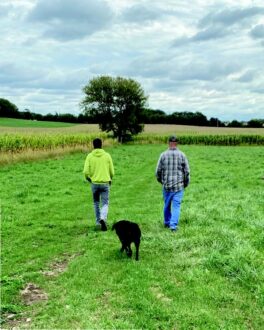Farming can be a community practice; however, farmers are increasingly “siloed” on the farm. As farms get bigger, help becomes scarce. Small towns lose coffee shops and feed mills, the social hub where farmers once shared information.
With support from a $39,900 NCR-SARE Partnership grant, Dane County Land Conservation was able to support and create intentional spaces for a group of farmers willing to take a chance on establishing and utilizing cover crops on their farms to improve soil health.
SARE funds were used through the project to bring new cover crop-adopting farmers to experienced farms to ask pointed questions, talk directly about equipment, and take tours of the farm. By funding these one-on-one “farmer dates,” specific questions often lost at large field days could be addressed, leading to better and quicker adoption of cover crops. By creating spaces for farmers to share ideas, successes, and failures, the farmers in Southern Dane County expanded cover crop implementation dramatically in just a few short years. The participating farmers opened their farms to anyone who wanted to learn more, share ideas, and even equipment.
To see landscape-scale changes, farmers need to feel support from their community. The most successful farmers have support from several levels within their community, from family, friends, and other farmers. This grant facilitated real change on a landscape scale by giving farmers the space to learn from one another and valuing the time of the experienced farmers. The change that has occurred can be seen driving 55 mph down a county road. The difference can also be seen as the confidence grows in a young group of farmers who want to improve water and soil quality on their farms. They are becoming leaders in their community.
A secondary outcome of this grant was that the farmers participating took their organization to the next level and formed a producer-led watershed group, advocating for biological systems thinking approaches to farming in Southern Wisconsin.
Although the farm sizes vary in range and focus, this group of farmers continues to innovate and lead in the field of true regenerative agriculture.
"This project has spurred plans to research and demonstrate new alternative cropping and cover cropping systems that allow for better liquid manure management with decreased runoff potential and increased nutrient utilization," said Raboin.
Dig Deeper
During the project, the team created a YouTube Channel called “Lawn Chair Farming.” The focus is on regenerative agriculture practices, including grazing and harvesting cover crops. Watch all six episodes on YouTube.
